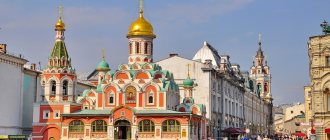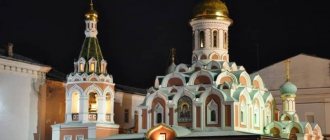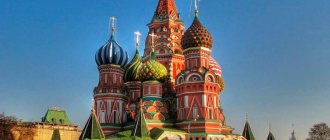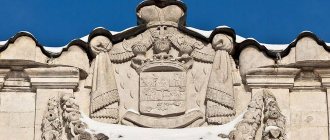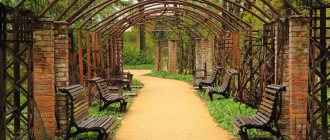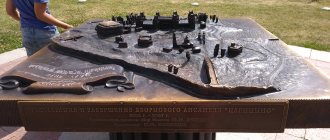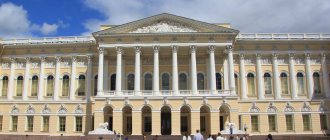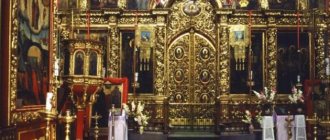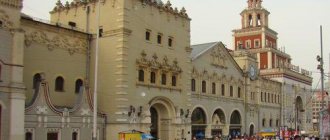It would seem that Moscow is a metropolis, the capital of Russia. But to find Catholic churches located in Moscow, you will have to try. Due to the small number of Catholics living here, there are several churches and chapels in the city that invite believers to come to services, have heart-to-heart conversations on religious topics, or listen to classical music.
Cathedral of the Immaculate Conception of the Blessed Virgin Mary today
Built in the neo-Gothic style, the temple building stands out among the nearby buildings with its austere and majestic appearance with unusual architecture.
The church on Malaya Gruzinskaya owes its name to one of the most important characters of the Christian faith - the Virgin Mary (Most Holy Theotokos, Queen of Heaven, earthly mother of Jesus Christ).
Architect, exterior decoration, architectural ensemble
The church began its history in 1894. At that time, the Catholic diaspora in Moscow was growing noticeably. As a result, its representatives raised the question with the Moscow governor about the need to build a larger temple capable of accommodating a large number of believers. By this time there were already 2 Catholic churches in Moscow.
The Moscow authorities issued permission for the construction of a religious building, but put forward certain conditions. The cathedral had to be built away from Orthodox holy places and not in the city center. At the same time, there should not be any statues or towers on the building.
The church on Malaya Gruzinskaya was designed by the architect F. Bogdanovich-Dvorzhetsky.
He developed and presented to the public a design for a cathedral in a neo-Gothic style that could accommodate 5,000 parishioners. At the same time, he ignored the conditions put forward regarding the absence of statues on the facade and towers.
Despite this, the project won the competition and was recommended for construction. A plot of land was purchased on Malaya Gruzinskaya Street for the construction of the cathedral.
Church of Saint Louis of France
This temple was consecrated on November 24, 1835. Initially, a wooden Catholic church stood in its place. The initiative regarding its construction was made by the Vice-Consul of France himself. Immediately after the fall of the Bastille - July 15, 1789 - he turned to Catherine II with a request for permission to build a Catholic church in Moscow. The Empress gave permission for its construction. However, at first the construction of the church was supposed to be in the German settlement. But the petitioners managed to convince the queen and obtain permission to build a temple not far from the Kuznetsky Bridge. It was in this area that many French lived in those days.
The Temple of Louis is notable for the fact that services here did not stop even after the revolution. However, they were carried out, of course, under the supervision of first the Cheka and then the KGB.
In 1950, the Church of Louis was solemnly transferred to the Catholic Church of the Baltic States. However, in 1991 it was returned to the French Church. After this, restoration work was carried out in the temple.
The Church of St. Louis is located on Malaya Lubyanka Street, building 12.
History of construction
The purchased plot had a certain significance for Catholics. This is where the main Polish diaspora lived. Representatives of this community collected the main funds for the construction of the cathedral. In total, the total cost of the temple was 300 thousand rubles. silver
Construction of the religious building began at the beginning of the 20th century. Its construction lasted almost 10 years. Completed at the end of 1911. In winter (December 21), the church was consecrated.
Interior decoration was carried out even after the opening, right up to the revolutionary events of 1917. During the first period of the formation of the Soviet Union, the Catholic Church did not close for almost 20 years. Regular services were held there.
However, the situation in the country nevertheless led to the closing of the cathedral in 1937.
The property of the religious building was looted and destroyed. The organ and altar were destroyed. The facade of the building was disfigured.
Subsequently, the building was used as a hostel and redevelopment began. During the Great Patriotic War, the cathedral was damaged by German bombs. A number of towers and spiers were lost. After the war, the main spire of the temple was dismantled. Reconstruction of the building continued.
In 1956, the Mospetspromproekt research institute moved into the former building of the Catholic Cathedral . This structure continued major internal reconstructions, changing it beyond recognition, creating 4 full floors.
Church before restoration
In 1976, the Moscow authorities decided to create an organ hall on the basis of the building. But the institutions that were located in the church building, and there were about 15 of them, categorically refused to move, which led to the refusal to implement cultural plans.
However, the Catholics of Moscow, united under their leadership by the Polish House association, continued their activities aimed at returning the religious building to the believers. In 1989, they submitted an official request to the Moscow authorities to return the temple building to the Roman Catholic Church.
The city authorities reacted favorably to the requests of believers and in 1990 the first mass was celebrated in front of the temple. It became iconic, the first in almost 60 years.
However, we had to wait another 5 years before the cathedral was completely returned to the possession of the capital’s Catholic diocese. The Mosspetspromproekt research institute refused to move out of the building.
The final point in the process of returning the church to believers was set in 1996, when the Moscow Catholic Diocese received from the city authorities documentary materials confirming the right to perpetual use of the building.
Immediately after the transfer of the church, restoration began. It dragged on for 3 years. At the end of 1999, the envoy of the Pope, Cardinal Sodano, illuminated the cathedral. A few years later an organ was installed in it.
Concerts in the Church of Peter and Paul
The first organ was purchased by this church back in 1892 in Germany. For a long time it was the best concert instrument in the capital. However, during the Second World War, in 1941, this organ was taken to Novosibirsk and disappeared. There is information that it was partially sold for scrap metal, and partially used as decoration.
In 1996, another organ was donated to the community. Not long before this, the old Lutheran church in Moscow in the German settlement was destroyed, and they decided to transfer the instrument specifically to the Church of Peter and Paul. Thanks to this organ, the church is currently not only a religious building, but also one of the cultural centers of the capital. The acoustics in the hall of this church are simply wonderful, so quite secular concerts are often held here.
Interior decoration
The interior of the cathedral is impressive. Thus, the spire of the central inner turret is decorated with a cross, into the side spiers of which the coats of arms of John Paul II and Archbishop Tadeusz Kondrusiewicz are inserted. In the vestibule of the temple there is a sculpture of Christ crucified on the cross. At the bowls with holy water, a brick from the Lutheran Lutheran Basilica and a special medal from the year 2000 are inserted into the walls.
In the central part of the church there are two sectors with benches. They are separated by passages. Next to the side passages there are rooms for confession - confessionals. On one side of the left nave (the nave is the part of the room bounded by columns) there is a chapel. Inside there is a tabernacle with an altar of Gifts.
The side naves are separated from the hall by a colonnade. Their ceilings are vaulted in the form of a cross, created by arches. Each nave is individually supported by five buttress columns. Their total number is 10, which symbolizes the 10 main Christian commandments.
Cathedral organ
The windows of the cathedral are lancet, with stained glass window openings. Below them there are 14 bas-reliefs that symbolize the 14 “stations” on the Way of the Cross. Next to the first ceiling arch, above the narthex (entrance area of the temple vestibule), a choir was erected. Previously, the cathedral project envisaged accommodating about 50 singers. However, a choral organ was installed in this place.
Catholic Church of Equal-to-the-Apostles Princess Olga
This is a new temple, consecrated recently. The decision to open it, since there were no longer enough existing Catholic churches, was made in 2000. In 2003, the parish was allocated the old building of the House of Culture. At the moment it is a functioning temple. Within its walls, among other things, there is an Alcoholics Anonymous club and charity events are held. The current rector of the temple is Peljak Dariusz Stanislaw. The Church of Equal-to-the-Apostles Princess Olga is located at Kirov proezd, building 6.
Shrines, icons, relics of the temple
In the central place of the church there is its main element - the altar. It is lined with dark green marble.
It contains particles of saints that belong to:
- To Chief Apostle Andrew;
- Saint Zeno (Zeno of Verona), patron saint of children and fishermen;
- Saint Gregory of Nazianza (Theologian or Gregory of Nazianzus) is venerated as one of the founders of the Church, Archbishop of Constantinople;
- Saints Cosmas and Dimian (brothers, unmercenaries, miracle workers and healers);
- a piece of the veil of the Virgin Mary , donated to the church by the Diocese of Verona.
On the right side of the altar is the pulpit. It is also in dark green marble. In the presbytery, in the rear part, there is an elevation consisting of 3 steps. It is adjacent to the apse (a semi-domed temple projection). There are places for clergy, as well as a bishop's chair.
The crucifixion is located in the presbytery. It reaches 9 meters in height. On the cross is Jesus Christ 3 meters high. On the sides of the crucifix are sculptures made of plaster: St. John the Evangelist and the Mother of God.
Clergy, mentors
The Church on Malaya Gruzinskaya has its own staff of clergy. Represented by the Metropolitan of the Moscow Archdiocese, the vicar general, the rector of the cathedral, cathedral administrators, two parish vicars, three priests responsible for assistance in the transition. There is a clergyman representing the Armenian Catholic parish and a priest from the Spanish community.
There are 6 sisters on staff. They represent 3 monastic orders: Salesians of Don Bosco; Daughters of Mary Help of Christians; Congregation of the Sacred Heart of Jesus.
Activities of the Temple of Louis
This Catholic church in Moscow has become a haven for several parishes and communities. In addition, tourists who come to the capital with their priest are also allowed to perform church rituals. Services in this temple are conducted in different languages - English, French, Italian, Russian, Lithuanian, Polish, etc.
The parish of St. Louis is active in charitable activities. For example, it helps African students who come to study in Moscow. A help center for those in need has been opened at the temple. People who find themselves in difficult life situations can come here for warm clothes or food.
Parish and choir
The parish of the church is extensive. It includes all Catholics living in the west and south of Moscow. Formally, these are parishioners of the parishes of the Immaculate Conception of the Blessed Virgin Mary and the Holy Family.
The church has its own choir, parish and liturgical. There is a choral singing class in the basement of the cathedral. It holds classes once a week, on Wednesdays. In addition, those who wish can try their hand at a youth vocal and instrumental ensemble.
Catholic churches in Russia: listen to the organ and admire the neo-Gothic style
The entry was published on November 28, 2021 by Daria Savelyeva in the category Finds for tourists with the tags travel, attractions, Christmas, cities, where to go, city of the week.
If you have been to Catholic cathedrals in Europe, then you probably admired the high windows and picturesque stained glass windows, slender spear-shaped towers and pointed spiers. There is some kind of enchanting beauty in this and the feeling that you find yourself in the medieval era.
You don't have to go to Europe to listen to Catholic Mass and organ music. We have found the most beautiful Catholic cathedrals in Russia that are worth visiting on December 25th during Catholic Christmas.
In Russia, Catholic cathedrals began to be built in the 19th-20th centuries. The neo-Gothic style of Russian Catholic cathedrals borrowed features from Western European medieval architecture.
Photo from photosight.ru
Construction of the Cathedral of the Immaculate Conception of the Blessed Virgin Mary began in 1900. Foma Bogdanovich-Dvorzhetsky designed the building in the neo-Gothic style - with a cruciform layout, bas-reliefs, lancet windows and stained glass windows. Researchers believe that the Moscow architect could have been inspired by the facade of Westminster Cathedral and the dome of the Cathedral in Milan. The third Catholic church in Moscow took 17 years to build and decorate.
Organ in the Roman Catholic Cathedral in Moscow
Today the Cathedral of the Immaculate Conception of the Blessed Virgin Mary is the largest Catholic cathedral in Russia. It is called “a piece of Europe” on Malaya Gruzinskaya Street. Here is the largest pipe organ in the country - it was donated by the cathedral from the Swiss city of Basel. This is the first Russian church to resume the centuries-old European tradition of church concerts. In addition to organ performances, there are concerts of instrumental, jazz and folk music. Divine services are held in Russian, Polish, Korean, Vietnamese, Latin; Tridentine masses and liturgies according to the Armenian rite are celebrated here.
View housing in Moscow
Church of St. Catherine of Alexandria in St. Petersburg
The first Catholic church in St. Petersburg was the Basilica of St. Catherine, a magnificent building on Nevsky Prospekt. The famous Dominico Trezzini, Valen-Delamot and Antonio Rinaldi had a hand in its construction. As a result, in 1782 Nevsky acquired one of his best decorations. By the way, the Basilica is the only one in Russia.
Inside St. Catherine's Basilica
Today the angels that decorated the facade have been removed, the plaster has peeled off, but the Basilica is still beautiful. It was consecrated in honor of Saint Catherine of Alexandria, a martyr who tried to call the Roman Emperor Maximin to renounce paganism. And, of course, with a hint of Catherine the Great.
Inside, the Basilica is decorated in soft pink and blue colors. Its wide dome evokes heaven, and its pillared walls, decorated with statues of angels, create a tranquility that is ideal for the temple's atmosphere.
Organ in St. Catherine's Basilica
The Basilica is the main Catholic church in St. Petersburg; in fact, even the title of basilica itself is awarded personally by the Pope. From morning to evening it is open to any person: be it a believer, a tourist or a simple passer-by - everyone can go inside and enjoy its beauty and tranquility. Some elements of the temple are still under restoration, but the Basilica performs all the functions of a religious institution.
View housing in St. Petersburg
Temple of the Sacred Heart of Jesus in Samara
In 1901, the St. Petersburg magazine “Zodchiy” published a design for the Catholic Church of the Sacred Heart of Jesus, which was also created by Thomas Bogdanovich-Dvorzhetsky. The red brick neo-Gothic building was erected in 1906.
Stained glass above the door to the temple
It was decorated with spear-shaped pinnacles - a stained glass window with the Virgin Mary above the entrance and golden stucco inside. Inside, they installed “a magnificent organ, imported from Austria and costing about 5,000 rubles,” as the Voice of Samara newspaper wrote in 1906.
In the 1930s the temple was closed. It housed a children's theatre, a local history museum, a theater technical school and a construction club. In 1991, the building was returned to the Catholic parish. It was restored and crosses were installed on the spiers.
Inside the Temple of the Sacred Heart of Jesus
Today, the Temple of the Sacred Heart of Jesus in Samara is included in the UNESCO cultural heritage list. Organ and classical music concerts are held here, there is a library, a Bible study group and the editorial office of a Catholic newspaper. In the altar of the cathedral there is a fresco "Christ of St. John of the Cross", a copy of a painting by Salvador Dali, and the main shrine of the temple - the relics of Martin de Porres, a Peruvian clergyman of the 17th century. He was the first black American to be canonized.
View housing in Samara
Catholic Church of the Blessed Virgin Mary in Vladivostok
Initially, it was planned to build the Church of the Blessed Virgin Mary according to the design of the Vladivostok architect Alexander Gvozdzievsky. But his idea turned out to be expensive, so the construction committee announced a competition.
In 1909, the Far East newspaper published a note about the winner, architect Vladimir Planson. Sketches of the interior were prepared by Warsaw artist Josef Szpetkowski. The church was built in the Eastern European Gothic tradition: with pointed spiers, vertical projections, carved pediments, stained glass windows and vaulted ceilings. In 1921, the temple was consecrated, although Plançon’s plan was not yet fully realized. The bell tower was installed here only in 2010.
Organ in the Catholic Church of the Blessed Virgin Mary in Vladivostok
In 1996, the first organ concert in the history of the Far East was played in the temple. Since then, organ and vocal-choral performances have been held here regularly. In 2015, a wind organ was built specifically for the temple in the Philippines - its external decoration resembles the facade of the Church of the Blessed Virgin Mary.
View housing in Vladivostok
Catholic Church of the Dormition of the Virgin Mary in Kursk
The Roman Catholic Church of the Assumption of the Blessed Virgin Mary was built in 1896 in the neo-Gothic style traditional for Catholic churches at the turn of the 19th and 20th centuries: lancet stained glass windows, corner spire-towers and gilded crosses on the building and the main gate. During these years, the Russian avant-garde artist Kazimir Malevich lived and worked in Kursk. He married his first wife, Kazimira Zlejc, here: the ceremony took place in a Roman Catholic church. A plaque on the building says so. Malevich baptized his daughter here.
In 1938, the temple was closed, the property was requisitioned, the rector and activists of the parish were shot, and an anti-religious museum was organized in the building. Later, the House of Culture was located here, and only in 1997 it was returned to the local Catholic diaspora.
Today, many elements of ancient decor have been restored in the decoration of the Roman Catholic church. Inside it is decorated with painted vaults, altar figures of the Blessed Virgin Mary, the Holy Apostles Peter and Paul, mosaics, carved benches and an organ. The church hosts charity concerts every month, at which Russian and foreign musicians perform.
View accommodation in Kursk
Church of the Transfiguration of the Lord in Krasnoyarsk
In 1911, the Church of the Transfiguration of the Lord was built in Krasnoyarsk according to the design of local architect Vladimir Sokolovsky. The facade of the neo-Gothic building is designed in the form of a stepped gable pediment, above the door there is a rosette traditional for Catholic churches, and on the sides of the facade there are two towers. The walls and vaults are made of red brick, and the base is made of granite.
Organ Hall in Krasnoyarsk
In 1936, the building was transferred to cultural objects. The architectural appearance of the temple suffered greatly during the years of Soviet power. After restoration in the 1980s, one of the halls began to be used for chamber concerts and musical lectures, and the organ of the Krasnoyarsk Philharmonic was also located there. Since 1993, the Catholic community and the organ hall have worked together. Classical, jazz and choral concerts are still given here today.
View housing in Krasnoyarsk
Photo by Yulia Novikova
Yalta: Roman Catholic Church of the Immaculate Conception of the Blessed Virgin Mary
The Catholic church (church) on Pushkinskaya Street in Yalta was built according to the design of the famous Russian architect N.P. Krasnov. In its architectural style, the building is similar to the construction of Western European medieval architecture. It should be noted that the church in Yalta is designed in strict colors outside and inside, without excessive pomp.
The building operated as a temple until 1928, and then it housed various organizations. Since 1988 it has become a concert hall for organ music. In 1993 it was again consecrated as a temple.
Organ in the Roman Catholic Church in Yalta
The main attraction of the church is undoubtedly the organ. It was installed in the 80s of the last century. The organ consists of 2,200 pipes and 34 registers, which make it possible to hold organ music evenings that are very popular among vacationers and guests of the city of Yalta. Therefore, this is a place of pilgrimage for tourists in Yalta.
View housing in Yalta
Interesting facts about the cathedral in the surrounding area
The church on Malaya Gruzinskaya Street is famous for its bells. They are located on the left side of the facade, behind the arch. There are only 5 bells. They were made in Poland at the world famous Falczynski factory. Donated to the cathedral by Bishop Skvorets. The largest reaches a weight of more than 900 kg.
Each bell has its own name (in descending order by weight):
- "Our Lady of Fatima".
- "John Paul II".
- "Saint Thaddeus"
- "Anniversary - 2000".
- "Saint Victor"
The bell sound is produced by an electronic machine.
Not far from the location of the church on Malaya Gruzinskaya Street there are other attractions of the capital:
- Moscow Zoo;
- monument to Mother Teresa.
- Embassy of the Polish Republic;
- Georgian Park;
- Cemetery Vagankovsky;
- Shchukin's city estate.
Social work, everyday life
Free tours are offered at the Cathedral. But only by appointment. Their times are Tuesday, Wednesday, Friday, when there are no services. Outside excursion groups can also visit the temple. But they also require prior agreement.
Catechesis activities (teaching the basics of the Catholic faith and the order of church life) are carried out in the church. The church shop and library are open to those interested. There is a canteen for the poor. The editors of the “Light of the Gospel” newsletter found refuge in the cathedral.
Ave Maria concert in the cathedral:
The Church on Malaya Gruzinskaya is regularly used by the Art of Good Foundation for organ concerts. Paid entrance. Ticket prices range from 300 to 3000 rubles. The schedule of performances can be found on the foundation's website.
Chapel of the Spanish-Portuguese Catholic Community
Catholic tourists can visit not only churches and temples in Moscow. In the capital there is also a chapel belonging to the community of this Christian denomination. It is located near the Cathedral. The community members are mainly students from Africa and Latin America. The chapel was opened in the 90s. Services are held there regularly. The community also organizes holiday meetings, fundraising, clothing and food for the needy, out-of-town meetings for Muscovites, etc. Its members take an active part in the lives of foreign students, support single mothers, etc. Services here are held in Portuguese and Spanish. . The chapel is located at Volkov Lane, 7/9, building 2, apt. eleven.
Sunday School
There is no Sunday school in the cathedral. Here you can only gain additional knowledge in the field of English. Classes are conducted in children's groups, since the main recipients of information are children. They are recruited from the age of 3 years.
English language courses have such features as a game form of teaching, a friendly atmosphere, and naturalness in language acquisition. Teachers who have experience working with children starting from 3 years of age are involved in the classes.
Service schedule, operating hours
The Roman Catholic Cathedral is open daily. It is open to the public from 8:00 to 20:00. Closed for a technical break from 12:45 to 15:30, except Sundays.
Catholic Easter
Divine services in the temple are held daily. The schedule is shown in the table.
Peter and Paul Lutheran Church
This Evangelical Lutheran church in Moscow was built in 1664. It was originally built from wood. The land for it was acquired by the artist Peter Inglis and General Bauman. In 1667, a larger temple, but also wooden, was erected in its place. At the same time, a pastor's house and a school were attached to it. However, the land came into the official possession of the Catholic community only in 1670. In 1685, the Church of Saints Peter and Paul was illuminated.
This wooden Catholic church in Moscow burned three times and was finally destroyed in 1812. At that time, the community had to move to a temporarily built prayer house.
In 1817, the Catholic community of Moscow bought the Lopukhins’ estate, located near the German Settlement. The house was rebuilt into a church at the expense of the King of Prussia. In addition, the Russian emperor also lent money for the construction of the church. The new church was illuminated in 1819. In the mid-19th century it was slightly expanded.
The building in which the parish operates today was built in 1903-1913. The author of the project was the English architect W. F. Walcott. The church was built by the Russian architect V. A. Kossov.
In 1924, this temple became the main Lutheran cathedral in the country. However, persecution of the church soon begins, and the activities of this parish are prohibited, and the building itself is transferred to secular institutions. At the same time, as in the case of the Cathedral of the Virgin Mary, the spire was demolished. The church was handed over to believers again in 1988. Divine services in the temple are held in Russian and German. The address of this church is Starosadsky Lane, building 7. A photo of the Church of Peter and Paul is located below.
Church opening hours
DaytimeName masses, service languageSunday 8.30 - 20.00 in Polish, Russian, Korean, Latin, children's mass, Armenian liturgy Monday 7.45 - 19.00 in Russian, Polish,Adoration of the giftsTuesday7.45 – 20.45 in Russian, Polish
adoration of the giftsWednesday7.45 – 18.00in Russian, adoration of the giftsThursday7.45 – 19.00in Russian, PolishFriday7.45 – 19.00in Russian, adoration of the gifts, vespers Saturday7.45 – 18.00in Russian, adoration of the gifts, Sunday in Russian
Where is it located, what is in the surrounding area, how to get there
The cathedral is located at the address: Moscow, Malaya Gruzinskaya street, building 27/13 . This religious institution has its own official website Catedra_ru
The most convenient way to get to the church without delay is the following:
- First you need to get off at the Krasnopresnenskaya metro station.
- Then move along Krasnaya Presnya Street in a western direction, towards Tretyakovsky Val.
- After 500 meters you need to turn onto Malaya Gruzinskaya Street, walking along it for about 600 m and the goal will be achieved.
Another popular way is to choose ground route transport. To the cathedral, which is located next to Klimashkina Street, take bus number 116. Its route starts at the Belorussky railway station.
Near the church on Malaya Gruzinskaya Street there are stops for other public transport. So you can use buses 12, 18, 35, 39, 40, 53, 64, 66, 69, 125, 567. Trolleybus: 54. Minibus: 254M.
